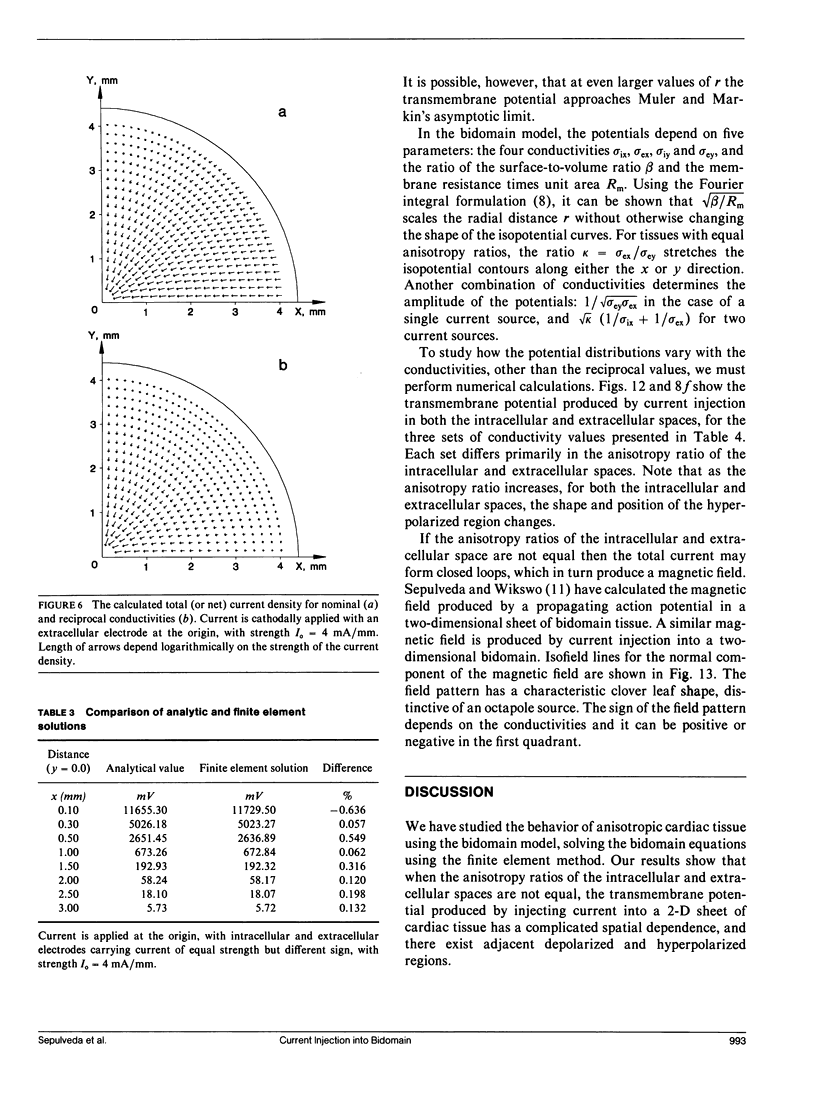Abstract
A two-dimensional sheet of anisotropic cardiac tissue is represented with the bidomain model, and the finite element method is used to solve the bidomain equations. When the anisotropy ratios of the intracellular and extracellular spaces are not equal, the injection of current into the tissue induces a transmembrane potential that has a complicated spatial dependence, including adjacent regions of depolarized and hyperpolarized tissue. This behavior may have important implications for the electrical stimulation of cardiac tissue and for defibrillation.
Full text
PDF












Selected References
These references are in PubMed. This may not be the complete list of references from this article.
- Barr R. C., Plonsey R. Propagation of excitation in idealized anisotropic two-dimensional tissue. Biophys J. 1984 Jun;45(6):1191–1202. doi: 10.1016/S0006-3495(84)84268-X. [DOI] [PMC free article] [PubMed] [Google Scholar]
- Eisenberg R. S., Barcilon V., Mathias R. T. Electrical properties of spherical syncytia. Biophys J. 1979 Jan;25(1):151–180. doi: 10.1016/S0006-3495(79)85283-2. [DOI] [PMC free article] [PubMed] [Google Scholar]
- Geselowitz D. B., Miller W. T., 3rd A bidomain model for anisotropic cardiac muscle. Ann Biomed Eng. 1983;11(3-4):191–206. doi: 10.1007/BF02363286. [DOI] [PubMed] [Google Scholar]
- Miller W. T., Geselowitz D. B. Simulation studies of the electrocardiogram. I. The normal heart. Circ Res. 1978 Aug;43(2):301–315. doi: 10.1161/01.res.43.2.301. [DOI] [PubMed] [Google Scholar]
- Muler A. L., Markin V. S. Elektricheskie svoistva anizotropnykh nervno-myshechnykh sintsitiev. I. Raspredelenie élektrotonicheskogo potentsiala. Biofizika. 1977 Mar-Apr;22(2):307–312. [PubMed] [Google Scholar]
- Peskoff A. Electric potential in three-dimensional electrically syncytial tissues. Bull Math Biol. 1979;41(2):163–181. doi: 10.1007/BF02460876. [DOI] [PubMed] [Google Scholar]
- Plonsey R., Barr R. C. Current flow patterns in two-dimensional anisotropic bisyncytia with normal and extreme conductivities. Biophys J. 1984 Mar;45(3):557–571. doi: 10.1016/S0006-3495(84)84193-4. [DOI] [PMC free article] [PubMed] [Google Scholar]
- Plonsey R., Barr R. C. Interstitial potentials and their change with depth into cardiac tissue. Biophys J. 1987 Apr;51(4):547–555. doi: 10.1016/S0006-3495(87)83380-5. [DOI] [PMC free article] [PubMed] [Google Scholar]
- Plonsey R., Barr R. The four-electrode resistivity technique as applied to cardiac muscle. IEEE Trans Biomed Eng. 1982 Jul;29(7):541–546. doi: 10.1109/tbme.1982.324927. [DOI] [PubMed] [Google Scholar]
- Roberts D. E., Hersh L. T., Scher A. M. Influence of cardiac fiber orientation on wavefront voltage, conduction velocity, and tissue resistivity in the dog. Circ Res. 1979 May;44(5):701–712. doi: 10.1161/01.res.44.5.701. [DOI] [PubMed] [Google Scholar]
- Roth B. J., Gielen F. L. A comparison of two models for calculating the electrical potential in skeletal muscle. Ann Biomed Eng. 1987;15(6):591–602. doi: 10.1007/BF02364251. [DOI] [PubMed] [Google Scholar]
- Roth B. J., Wikswo J. P., Jr A bidomain model for the extracellular potential and magnetic field of cardiac tissue. IEEE Trans Biomed Eng. 1986 Apr;33(4):467–469. doi: 10.1109/TBME.1986.325804. [DOI] [PubMed] [Google Scholar]
- Sepulveda N. G., Wikswo J. P., Jr Electric and magnetic fields from two-dimensional anisotropic bisyncytia. Biophys J. 1987 Apr;51(4):557–568. doi: 10.1016/S0006-3495(87)83381-7. [DOI] [PMC free article] [PubMed] [Google Scholar]


